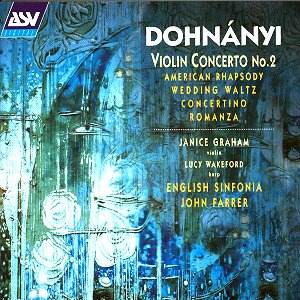I must confess to being utterly charmed and won over by anything Dohnanyi
wrote, for he is both a supreme melodist and a superb orchestrator.
The opening and closing works here make both points, the first (his
last orchestral work written in 1953) is cleverly and wittily packed
with quotations from ‘On top of Old Smokey’ to ‘Sir Roger de Coverley’
with Dvorak’s New World symphony in between. Like the latter
work, it is the product of an Eastern European artist resident in the
United States at the time, though whereas Dvorak’s was only a matter
of long visits Dohnanyi as an exile had emigrated and taken American
nationality. The Waltz, highly Straussian (J and R), comes from his
first stage work, a ballet called The Veil Of Pierette and written
in 1908/9.
In between come the two concertos. The Harp Concertino
also written in America (1952) is a really beautiful work, compactly
presented in a single movement. The writing is highly idiomatic and
typically French in style (Debussy and Ravel never far away), well suited
to the instrument, and exploring many of its achievable effects. By
way of contrast the second of his violin concertos (1949/50), begins
astringently in a rather unclear and even threatening idiom, but then
blossoms into a full Korngold-flowering of highly lyrical music. Like
the Second Piano Concerto by Brahms (a strong influence) it is a four-movement,
almost symphonic, structure, cadenzas abound, virtuosic playing is called
for. It is one of the last in the mould of the great Romantic violin
concertos. Dohnanyi may have encouraged his younger compatriots, Bartók
and Kodaly but he certainly never wrote like them, although all three
imbue their music with a true Hungarian flavour.
The music is given fine performances by all concerned.
Janice Graham vacates her Leader’s desks (with the English Sinfonia
featured here and the BBC National Orchestra of Wales) and rises to
the tricky demands of the concerto with sweet-toned, full-blooded playing.
In the Harp Concertino Lucy Wakeford is outstanding. The American conductor
John Farrer secures fine playing from the English Sinfonia, an orchestra
with a chequered past but, on the basis of this recording, a bright
future. It makes a good companion disc to the ones of Dohnanyi’s music
issued by Chandos (CHAN 9733) of the Suite, Nursery Theme Variations,
and a larger, four-movement selection (including the Wedding Waltz)
from the Veil of Pierette, with the BBC Philharmonic under Matthias
Bamert three years ago, and the two companion discs of the two symphonies
(CHAN 9647 and CHAN 9455 respectively).
Christopher Fifield

![]() Janice Graham (violin)
Janice Graham (violin)
![]() ASV CD DCA 1107 [71.23]
ASV CD DCA 1107 [71.23]